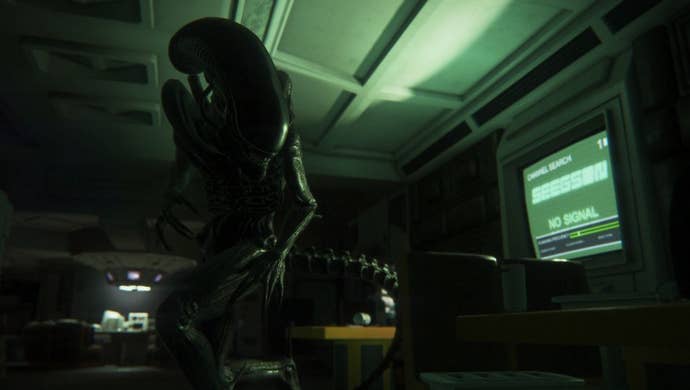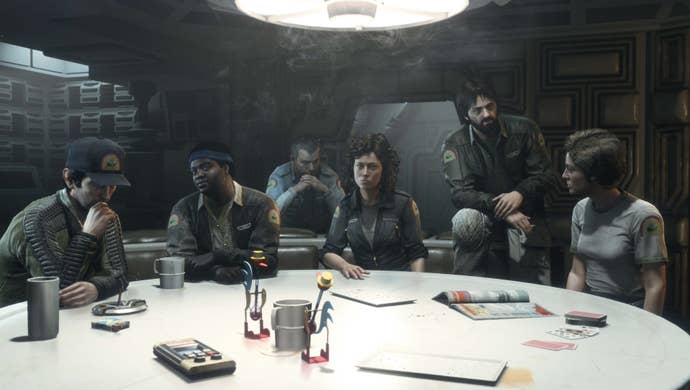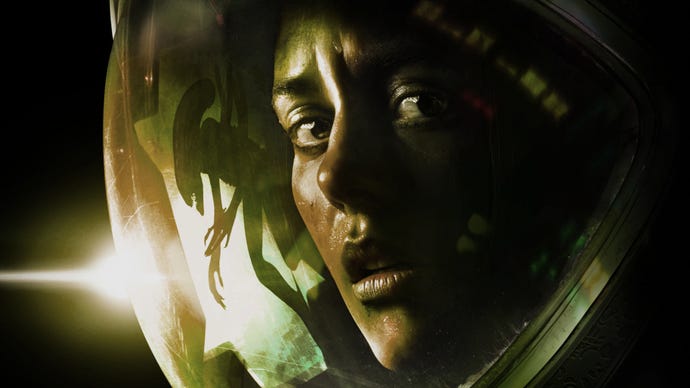Nine years later, Alien: Isolation is an unmatched horror gem – and the high-tide of licensed games
The scariest Xenomorph out there is probably the one stalking Amanda Ripley, and the star of Creative Assembly’s extraordinary horror game.
Saving your game shouldn’t be so stressful. Getting to a Registration Point and operating the key card-activated, payphone like system – it takes seconds. But seconds are precious. Especially when there’s something, somewhere nearby, lurking. Waiting. Breathing. Watching. You’re pressing the skin of your face to the inside of a locker, eyeing up that terminal, knowing it’s less than 20 feet away, probably. But, moments ago, you heard the telltale ding of sinew on metal. The Xenomorph is nearby. And it’s waiting for you to make your move.
Time is running out. Both in the game, and in your real life – you need to save, and get on with that article you’re supposed to be writing. So you close your eyes, take a deep breath, and try to slink out of the little cupboard you’ve crammed yourself into as quietly as possible. A glance at your motion tracker seems to suggest you’re safe. Footsteps echoing through the deserted Sevastopol station. Breath ragged in your ears. The blinking light of the terminal closing in. Your hand on the machine. Then – f**k – it’s coming up and out of your chest. Its tail, tearing through your ribs, your lungs. That’s it. Game over, Ripley.

Some may argue that this is appalling game design, making you gamble on whether or not you can actually save your game. You can lose hours of progress if you mess up your timing, if you gamble against Ripley’s ability to stay alive. But I think it perfectly encapsulates what makes Alien: Isolation one of the best games, ever. Even saving your game makes you think about survival – makes you think about death.
In other games, you’d open a menu and hit a button, putting the game down for the night and letting your brain drift back to reality. But in Alien: Isolation, as you take a deep breath and think about whether saving is going to push your back even harder against the cold, abandoned walls of the Sevastopol, you feel the game get its claws in you. You don’t save and go off to make dinner without a second thought, no – you leave a bit of your cortex with Amanda Ripley. With the Xenomorph.
The game thoroughly ripped apart the first film to make the Space Station Sevastopol hum with authenticity. Post-processing effects were used to recreate the visual distortion you get in films from the late 70s, chromatic aberration is deployed deftly to make it look like you really are viewing this whole nightmare through an old CRT monitor. Lens flare glints off your camera as you peek around corners. Film grain washes over the screen as you bait your breath and listen.
But it wasn’t just the retro-futuristic bakelite panels and buzzing fluorescent lights that Creative Assembly unpicked and repackaged – the studio also methodically laid out all the tropes of the first (best) Alien. The horror, the slow-building dread, the knowledge that the idea of the Xenomorph is scarier than the physical manifestation of it, the constant threat of death, the bait or survival, and the balancing of cortisol and adrenaline.

Throughout the whole game, Alien: Isolation remains subdued, unsettling, malicious. It never needs to rely on jump scares or over-wrought scripted moments, because its setting, its monster, and its player work in perfect harmony to create the perfect horror triad: you need to live, it needs to kill. That’s the crux of it. The disquieting feeling of knowing that nothing is scripted – that the alien will do as it pleases, responding only to the stimuli you provide for it – makes you feel like every death is your own fault. That you haven’t been quiet enough, or that you’ve severely, fatally underestimated your foe.
Alien: Isolation is the best horror game I’ve ever played, purely because I can’t predict how any given level is going to play out. You can slink from doorway to doorway a thousand times, and never know whether the Xenomorph is tucked away in a vent above you, stalking the canteen over there, or right behind you, ready to tear your face off. It makes you feel fragile, and – because saving is such a precious resource in this game – it makes you fear death in a way modern games rarely do.

And, unlike a host of other games, you cannot simply brute force your way out of this one. You can’t just play it cool, scraping bullets off the floor and shakily loading them into your pistol before unloading them in a hail of hot lead in the creature’s skull(s). No, a gun in this game makes you the target – one gunshot ringing out through these dilapidated halls will be a beacon to the Xenomorph. Instead, the onus is on scavenging for spaceship flotsam – bits of unused engineering scrap that can be kitbashed together to make rudimentary, momentary distractions from the cold, unreasonable death nipping at your heels.
Alien: Isolation works so well because it leverages a world you know with a predator you think you know, and uses the tools Creative Assembly installed so adeptly to constantly undermine your expectations. Alien: Isolation weaponises uncertainty, and uses you – player – against yourself. The game takes a sadistic pleasure in learning how you operate, how you play games, and bides its time until you’re feeling just a bit too brave. A bit too confident. Then, it will kill you without mercy or remorse. Even if you’re in the middle of saving your game.






